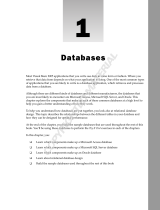
English part but retaining the pronunciation to identify it with its predecessor. Today, several implemen-
tations of SQL by different stakeholders are in the database marketplace, and as you sojourn through the
sometimes-mystifying lands of database technology you will undoubtedly encounter these different
varieties of SQL. What makes them all similar is the ANSI standard to which IBM, more than any other
vendor, adheres to with tenacious rigidity. However, what differentiate the many implementations of
SQL are the customized programming objects and extensions to the language that make it unique to that
particular platform. Microsoft SQL Server 2000 implements ANSI-92, or the 1992 standard as set by
ANSI. SQL Server 2005 implements ANSI-99. The term “implements” is of significance. T-SQL is not
fully compliant with ANSI standards in its 2000 or 2005 implementation; neither is Oracle’s P/L SQL,
Sybase’s SQLAnywhere, or the open-source MySQL. Each implementation has custom extensions and
variations that deviate from the established standard. ANSI has three levels of compliance: Entry,
Intermediate, and Full. T-SQL is certified at the entry level of ANSI compliance. If you strictly adhere to
the features that are ANSI-compliant, the same code you write for Microsoft SQL Server should work on
any ANSI-compliant platform; that’s the theory, anyway. If you find that you are writing cross-platform
queries, you will most certainly need to take extra care to ensure that the syntax is perfectly suited for all
the platforms it affects. Really, the simple reality of this issue is that very few people will need to write
queries to work on multiple database platforms. These standards serve as a guideline to help keep query
languages focused on working with data, rather than other forms of programming, perhaps slowing the
evolution of relational databases just enough to keep us sane.
T-SQL: Programming Language or Query Language?
T-SQL was not really developed to be a full-fledged programming language. Over the years the ANSI
standard has been expanded to incorporate more and more procedural language elements, but it still
lacks the power and flexibility of a true programming language. Antoine, a talented programmer and
friend of mine, refers to SQL as “Visual Basic on Quaaludes.” I share this bit of information not because I
agree with it, but because I think it is funny. I also think it is indicative of many application developers’
view of this versatile language.
The Structured Query Language was designed with the exclusive purpose of data retrieval and data
manipulation. Microsoft’s T-SQL implementation of SQL was specifically designed for use in Microsoft’s
Relational Database Management System (RDBMS), SQL Server. Although T-SQL, like its ANSI sibling,
can be used for many programming-like operations, its effectiveness at these tasks varies from excellent
to abysmal. That being said, I am still more than happy to call T-SQL a programming language if only to
avoid someone calling me a SQL “Queryer” instead of a SQL Programmer. However, the undeniable fact
still remains; as a programming language, T-SQL falls short. The good news is that as a data retrieval
and set manipulation language it is exceptional. When T-SQL programmers try to use T-SQL like a pro-
gramming language they invariably run afoul of the best practices that ensure the efficient processing
and execution of the code. Because T-SQL is at its best when manipulating sets of data, try to keep that
fact foremost in your thoughts during the process of developing T-SQL code.
Performing multiple recursive row operations or complex mathematical computations is quite possible
with T-SQL, but so is writing a .NET application with Notepad. Antoine was fond of responding to these
discussions with, “Yes, you can do that. You can also crawl around the Pentagon on your hands and
knees if you want to.” His sentiments were the same as my father’s when I was growing up; he used to
make a point of telling me that “Just because you can do something doesn’t mean you should.” The
point here is that oftentimes SQL programmers will resort to creating custom objects in their code that
2
Chapter 1
04_57955x ch01.qxd 9/19/05 12:43 PM Page 2




























